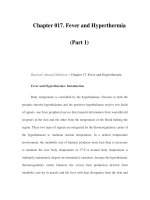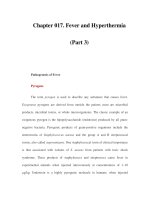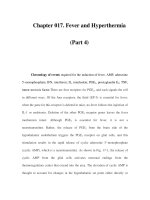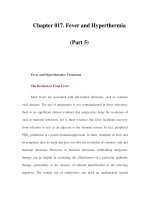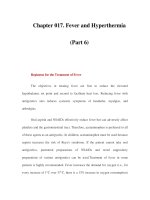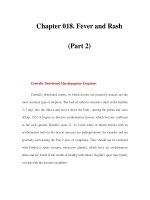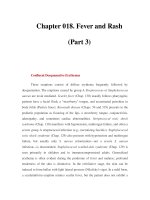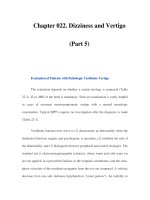Chapter 017. Fever and Hyperthermia (Part 5) pdf
Bạn đang xem bản rút gọn của tài liệu. Xem và tải ngay bản đầy đủ của tài liệu tại đây (58.42 KB, 5 trang )
Chapter 017. Fever and Hyperthermia
(Part 5)
Fever and Hyperthermia: Treatment
The Decision to Treat Fever
Most fevers are associated with self-limited infections, such as common
viral diseases. The use of antipyretics is not contraindicated in these infections:
there is no significant clinical evidence that antipyretics delay the resolution of
viral or bacterial infections, nor is there evidence that fever facilitates recovery
from infection or acts as an adjuvant to the immune system. In fact, peripheral
PGE
2
production is a potent immunosuppressant. In short, treatment of fever and
its symptoms does no harm and does not slow the resolution of common viral and
bacterial infections. However, in bacterial infections, withholding antipyretic
therapy can be helpful in evaluating the effectiveness of a particular antibiotic
therapy, particularly in the absence of cultural identification of the infecting
organism. The routine use of antipyretics can mask an inadequately treated
bacterial infection. Withholding antipyretics in some cases may facilitate the
diagnosis of an unusual febrile disease. For example, the usual times of peak and
trough temperatures may be reversed in typhoid fever and disseminated
tuberculosis. Temperature-pulse dissociation (relative bradycardia) occurs in
typhoid fever, brucellosis, leptospirosis, some drug-induced fevers, and factitious
fever. In newborns, the elderly, patients with chronic renal failure, and patients
taking glucocorticoids, fever may not be present despite infection, or core
temperature may be hypothermic. Hypothermia is often observed in patients with
septic shock.Some infections have characteristic patterns in which febrile episodes
are separated by intervals of normal temperature. For example, Plasmodium vivax
causes fever every third day, whereas fever occurs every fourth day with P.
malariae. Other relapsing fevers are related to Borrelia infections, with days of
fever followed by a several-day afebrile period and then a relapse of days of fever.
In the Pel-Ebstein pattern, fever lasting 3–10 days is followed by afebrile periods
of 3–10 days; this pattern can be classic for Hodgkin's disease and other
lymphomas. In cyclic neutropenia, fevers occur every 21 days and accompany the
neutropenia. There is no periodicity of fever in patients with familial
Mediterranean fever.
Recurrent fever is documented at some point in most autoimmune diseases
and all autoinflammatory diseases. The autoinflammatory diseases include adult
and juvenile Still's disease, familial Mediterranean fever, hyper-IgD syndrome,
familial cold-induced autoinflammatory syndrome, neonatal-onset multisystem
autoinflammatory disease, Blau syndrome, Schnitzler syndrome, Muckle-Wells
syndrome, and TNF receptor–associated periodic syndrome.
Besides recurrent fevers, neutrophilia and serosal inflammation
characterize these diseases. The fevers associated with these illnesses are
dramatically reduced by blocking of IL-1β activity. Anticytokines therefore reduce
fever in autoimmune and autoinflammatory diseases. Although fevers in
autoinflammatory diseases are mediated by IL-1β, patients also respond to
antipyretics.
Mechanisms of Antipyretic Agents
The reduction of fever by lowering of the elevated hypothalamic set point is
a direct function of reducing the level of PGE
2
in the thermoregulatory center. The
synthesis of PGE
2
depends on the constitutively expressed enzyme
cyclooxygenase.
The substrate for cyclooxygenase is arachidonic acid released from the cell
membrane, and this release is the rate-limiting step in the synthesis of PGE
2
.
Therefore, inhibitors of cyclooxygenase are potent antipyretics.
The antipyretic potency of various drugs is directly correlated with the
inhibition of brain cyclooxygenase. Acetaminophen is a poor cyclooxygenase
inhibitor in peripheral tissue and lacks noteworthy anti-inflammatory activity; in
the brain, however, acetaminophen is oxidized by the p450 cytochrome system,
and the oxidized form inhibits cyclooxygenase activity. Moreover, in the brain, the
inhibition of another enzyme, COX-3, by acetaminophen may account for the
antipyretic effect of this agent.
However, COX-3 is not found outside the CNS.Oral aspirin and
acetaminophen are equally effective in reducing fever in humans. Nonsteroidal
anti-inflammatory drugs (NSAIDs) such as ibuprofen and specific inhibitors of
COX-2 are also excellent antipyretics.
Chronic, high-dose therapy with antipyretics such as aspirin or any NSAID
does not reduce normal core body temperature. Thus, PGE
2
appears to play no role
in normal thermoregulation.
As effective antipyretics, glucocorticoids act at two levels. First, similar to
the cyclooxygenase inhibitors, glucocorticoids reduce PGE
2
synthesis by
inhibiting the activity of phospholipase A
2
, which is needed to release arachidonic
acid from the cell membrane.
Second, glucocorticoids block the transcription of the mRNA for the
pyrogenic cytokines. Limited experimental evidence indicates that ibuprofen and
COX-2 inhibitors reduce IL-1-induced IL-6 production and may contribute to the
antipyretic activity of NSAIDs.
